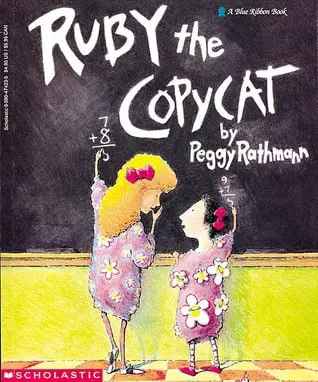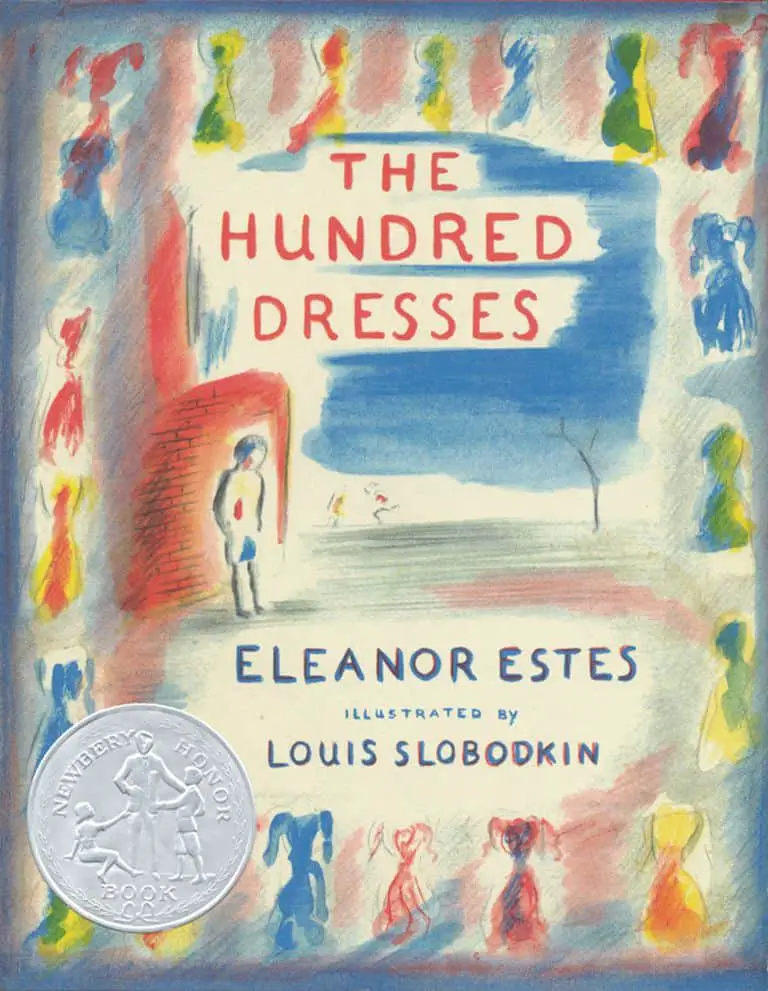The Hundred Dresses is a middle grade American novel by Eleanor Estes, first published 1944. I consider this story a children’s literature sister of Katherine Mansfield’s short story “The Doll’s House“. The Hundred Dresses remains resonant with young readers today, and is happily still in print after winning a Newbery Honor. (The medal was awarded to Rabbit Hill by Robert Lawson that year.)
The Hundred Dresses is illustrated by Louis Slobodkin in his usual loose watercolour and sketchy style. Slobodkin was a good choice, since he shared in common with fictional Wanda Petronski a non-Anglo last name in a more overtly racist era — a rare #OwnVoices before #OwnVoices was a thing.
THE HUNDRED DRESSES AND ME
I was 10 years old when my Year 6 teacher read us The Hundred Dresses. He said, “I normally read this book when I suspect bullying problems. I don’t think there are problems like this going on in this class, but I’m going to read it anyway.” I immediately wondered if he knew what was going on.
After he’d read The Hundred Dresses, I knew he had seen what was going on. He’d seen at least some of it. I knew it was a little about me.
This was the eighties. The ‘Mean Girl’ group started up in full force that year. The Mean Girls themselves were victims in a system which requires women and girls to look a certain way. They wore tan coloured pantyhose under their short skirts, even on hot days, because suntans were in fashion. There was a hierarchy regarding who had the most ear piercings. Some of the piercings extended right up into the painful cartilage area of their ten-year-old ears. They tied their hair in a whale spout fountain.
I wasn’t one of those girls. Unlike in Estes’ book, this wasn’t about socioeconomic status. Our hierarchy was a kind of rich-poor inversion. These girls with the piercings and the whale spouts had the most permissive parents. They rode their bikes around the neighbourhood all evening in summer, unsupervised. Their families didn’t seem to have much money. The girls somehow found cash for pantyhose and stud earrings. But when they learned I’d been enrolled in karate (they turned up one evening on their bikes and peered through the dojo — classroom — window), they expressed their envy the following day. “How long have you been doing karate?” they asked, envious, because The Karate Kid was new out. I felt little bad for them then. Extra curricular activities were for ‘rich’ kids, like me. If my parents seemed rich to them it was because my folks were so very careful about money.
Case in point: The school photographer was bad at his job. He took a portrait of me with my eyes closed. I carried it home feeling the utmost shame. You weren’t supposed to blink for photos and I had been bad. Film was expensive. You were supposed to stare at the camera with a smile affixed to your face. If your eyes were closed it was all your fault. My mother was dismissive, borderline disgusted. “I’m not paying five dollars for that,” she said. “You can take it right back.”
Masking my shame, I had to return the stupid photo to school. The worst of it was, I was smiling as directed. Grinning with my eyes closed, I looked like a simpleton. I placed the portrait discreetly upon the teacher’s desk. But I was the only kid in the class whose parents didn’t pay the five bucks for their portrait. The teacher said nothing, thank goodness. But that afternoon, the girl with the most elaborate fountain of ponytail cornered me near my box. (We had boxes, not individualistic desks — our teacher was a Rudolph Steiner type). She said, “I know why your mum didn’t buy your photo. You’re too ugly.”
My mother did pay for the class photo, though not for the portrait. I don’t look at it much. Then, last year, as most of my class turned 40, someone tagged me in it on Facebook. It struck me how similar my ten-year-old self looked to that nasty girl with the most flamboyant fountain ponytail. Same height, same build, same freckled face. By any measure, our ten-year-old selves are identical on glossy paper. If this were fiction, she’d be my foil character.
Back in 1988, I believed what this identical-looking classmate said about me. To clarify, I knew ugliness had not been the reason my mother sent the photo back. But I suspected this girl was right, in a general way, about ‘ugly’. I had no piercings and a bad haircut, not quite long enough to tie up. I looked kind of like a boy (by design, actually). I was the youngest in my year. I (gladly) hadn’t hit puberty. I wore homemade, practical athletic clothes, sewn with love, if not by fashion, by my auntie who owned an overlocker and sold polar fleece jumpers at the Saturday Morning Market. These clothes were great for running around in, and when I wasn’t reading Ramona Quimby in the school library, I ran around a lot. But elastic is a precious resource, so my track pants featured two stripes instead of the superfluous Adidas triple, which marked the apex of Year 6 status at that time.
I wonder if our teacher overheard that insult by the boxes when he decided to read The Hundred Dresses to our class. He could’ve heard any number of others.
I do wonder what that girl is doing now. I’ll never know, because nobody tagged her in our class photo 30 years later. I left the town after Year Six, because my father was transferred to the city. I didn’t attend high school with that cohort, and had spent only two years with them in total. So I was surprised anyone remembered my name to tag me in a photo. I’d aimed for invisible.
Back in Year Six, Marie was the opposite of invisible. Fast forward three decades, I wonder if anyone else remembers her name at all.
THE HUNDRED DRESSES AND HUMAN PSYCHOLOGY
WOMEN OBSESSED OVER WOMEN
Lately, lots of people are talking about the highly promoted TV series Killing Eve, which features a woman increasingly obsessed with another woman. The BBC’s Woman’s Hour podcast discussed other similar dynamics in fiction (at 31 minutes)and I thought immediately of Hundred Dresses as the children’s book equivalent of:
- Eve and Villanelle in Killing Eve
- Mrs Danvers in Rebecca
- Barbara in Notes On A Scandal
- Three women all obsessed with each other in The Favourite (2018)
- The Bostonians by Henry James
- Many French novels, usually set in school, usually someone younger who becomes obsessed.
- Sarah Waters does it beautifully in Affinity and The Paying Guests
- The Woman Upstairs by Clare Messud
- The Neapolitan novels by Elena Ferrante
- Sleep With Me features a character who inspires obsession in others
- All About Eve (1950)
- Black Swan
In each of these stories there’s a possessive charge between each of these women and their objects, whether that’s sexual, intellectual or whatever. It’s about owning a piece of another person.
Why do audiences respond so well to this dynamic?
- Despite all the examples above, we don’t see it all that often. There’s a current trend of writing ‘strong women’ who support each other. These stories are necessary too, but there are also conniving, devious, treacherous women. Audiences want to see all kinds of dynamic, not just the idealised ones.
- The male gaze is default in narrative, so watching a woman gaze at another woman feels refreshing in a different kind of maybe-feminist way.
- This kind of relationship is about identity and self-lack and not necessarily about the object in the way the gazer thinks it is. So the nature of the gaze is different. It’s turned inward.
- In the past, authors have hidden behind the male gaze. Willa Cather is one example. (Cather wrote “Paul’s Case“.)
- Women’s lust for power is rarely represented. It’s a new take on power dynamics. In the past it was more of a ‘woman catfight’.
- The woman with the obsession is lacking something in her own life. She watches another woman from the sidelines, fascinated.
- There’s a freedom that comes from watching another woman have the courage to do all the things you want to do yourself.
- We rarely see two female leads on screen unless it’s this dynamic.
I have seen literary agents who represent young adult fiction lament the huge number of submissions they get about the viewpoint character best friend looking on at the life of the cool, interesting, sparky best friend. This probably speaks to a common pitfall for writers — both characters must be equally interesting in their own right.
DEHUMANISATION IN THE HUNDRED DRESSES
We view minorities and the vulnerable as less than human. One striking example of this blatant dehumanisation came from a brain-scan study that found a small group of students exhibited less neural activity associated with thinking about people when they looked at pictures of the homeless or of drug addicts, as compared with higher-status individuals. Another study showed that people who are opposed to Arab immigration tended to rate Arabs and Muslims as literally less evolved than average. Among other examples, there’s also evidence that young people dehumanise older people; and that men and women alike dehumanise drunk women. What’s more, the inclination to dehumanise starts early – children as young as five view out-group faces (of people from a different city or a different gender to the child) as less human than in-group faces.
The Bad News On Human Nature, Aeon
STORY STRUCTURE OF THE HUNDRED DRESSES
Many children’s stories (as well as stories for adults) begin in the iterative and switch to the singulative. The Hundred Dresses feels slightly unusual for its time because it begins from the very first word, in the singulative:
Today, Monday, Wanda Petronski was not in her seat.
Then, in small chunks, we get the iterative:
Usually Wanda sat in the next to the last seat in the last row in Room 13…
SHORTCOMING
Wanda is ‘very quiet and rarely said anything at all. And nobody had ever heard her laugh out loud.’
‘She came all the way from Boggins Heights, and her feet were usually caked with dry mud that she picked up coming down the country roads. […] No one really thought much about Wanda Petronski’.
DESIRE
For everyone, the deep desire is identical — to have as much social capital as possible.
In a story there have to be outworkings. For Wanda, it’s the desire to have everyone believe that she has more than the one worn dress in her closet.
For Peggy and Maddie, it’s the Desire to have friends who are truthful and transparent, and in order to achieve this end they must ostracise those who they feel don’t follow the moral code of their community. They have been taught that lying is wrong; they will therefore punish liars. Since they are girls, they aren’t allowed to be outright mean, so they will do this is in a nasty-nice way.
OPPONENT
Old Man Svenson is set up as the potential Baddie in this story.
People in the town said old man Svenson was no good. He didn’t work and, worse still, his house and yard were disgracefully dirty, with rusty tin cans strewn about and even an old straw hat. He lived alone with his dog and his cat.
But we’re all used to the classic Girl Opposition, which contains archetypes:
- The popular pretty girl (Peggy)
- Her sidekick (Maddie) Is the narrator Maddie? The narrator has excellent insight into Maddie’s head — she feels guilty for being a bystander to ostracism.
- The unpopular girl (Wanda)
- Various other by-standers
Peggy was the most popular girl in school. She was pretty; she had many pretty clothes and her auburn hair was curly. Maddie was her closest friend.
A Hundred Dresses remains a standout book because of its treatment of bullying, as a system rather than a good kid, bad kid dichotomy, which is not how bullying works:
Peggy was not really cruel. She protected small children from bullies. And she cried for hours if she saw an animal mistreated. If anybody had said to her, “Don’t you think that is a cruel way to treat Wanda?” she would have been very surprised. Cruel? What did the girl want to go and say she had a hundred dresses for? Anybody could tell that was a lie. Why did she want to lie? And she wasn’t just an ordinary person, else why would she have a name like that? Anyway, they never made her cry.
Readers will likely sympathise with Peggy a little, or a lot. After all, Wanda appears to be a liar. If Magritte were about, he would say “This is not a dress.” (It is a picture of a dress.) It is a little baffling why Wanda won’t say that her dresses are pictures — this is lampshaded at the beginning with the description that she doesn’t say much. Her laconic way of speaking seems to preclude her from uttering the simple words “I have drawings of pictures.”
ENEMY VS NEMESIS
There is a kind of rivalry, as mentioned above, which is a more like a love-hate relationship. I appreciate what Roxane Gay has to say about the distinction between an ‘enemy’ and a ‘nemesis’. We tend to love our nemeses as much as we hate them:
There are many famous nemeses both real and imagined — Batman and the Joker, Superman and Lex Luthor, Professor X and Magneto, Aaron Burr and Alexander Hamilton, Eve and Villanelle.
The most important thing to remember is that the rivalry must be tended to, nurtured. It is an eternal flame, the heat of which can warm you during dark times.
An enemy is a nuisance but a nemesis is someone for whom you harbor an abiding, relentless dislike. A nemesis must be a worthy adversary. It is far too easy for someone completely odious to be a nemesis. People often ask if, for example, the President is my nemesis but that would absolutely be beneath me. Envy is certainly part of having a nemesis but it is not quite jealousy because generally you and your nemesis are equals in some way, even if you are the only person who believes that to be true. A nemesis can give you purpose, can hone your ambition. What I am saying is that having a nemesis is motivational.
The Pleasure of Clapping Back, Gay Mag
But the way Eleanor Estes structures it: The opposition is kept as the final big reveal.
PLAN
When there is a drawing competition at school Wanda takes this opportunity to reveal that the dresses are drawings of dresses. She enters every image into the competition.
After Wanda leaves the character focus shifts to Peggy and Maddie. Because they feel bad, their plan is to write a letter to Wanda as a friendly gesture. This will assuage their own guilt.
BIG STRUGGLE
Wanda disappears. Her father says she has been bullied. The teacher gives the class a lecture. Wanda is basically the blow-in saviour trope, so now the Battle is internal, focusing on the psychology of Maddie. She feels guilt.
ANAGNORISIS
The first plot revelation is that Wanda was talking about dresses.
The second revelation is that Wanda drew the popular girls as models for her dresses.
What is not revealed is how the poor girl really feels about the rich one. Does Wanda genuinely admire Peggy? We are left thinking that, and as a child I did think that, but how does she feel, really?
I suspect this is a love-hate relationship from her side, and a nothing, you’re-less-than-nothing relationship from the other.
It is the rich girl who has the Anagnorisis — that even when you pay someone no mind, that doesn’t mean they feel the same about you. The moral? Treat everyone with respect, no matter how worthy you deem them. Everyone is worthy of your attention. Attention equals respect.
NEW SITUATION
Peggy and Maddie have learned to be less passive aggressive in future because they have learned that Wanda is a rounded individual with feelings rather than a figure of fun.

It’s the first day of school, and Ruby is new. When her classmate Angela wears a red bow in her hair, Ruby comes back from lunch wearing a red bow, too. When Angela wears a flowered dress, suddenly Ruby’s wearing one, too. Fortunately, Ruby’s teacher knows a better way to help Ruby fit in–by showing how much fun it is to be herself!



